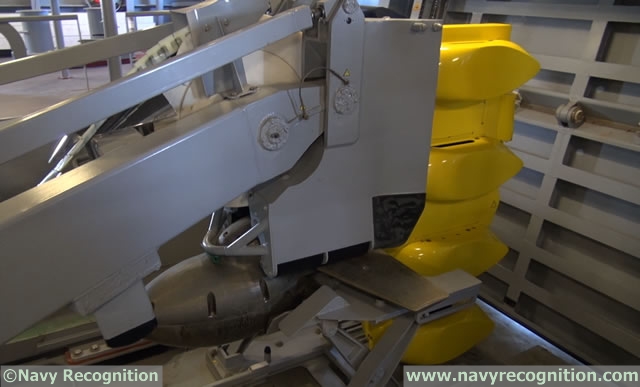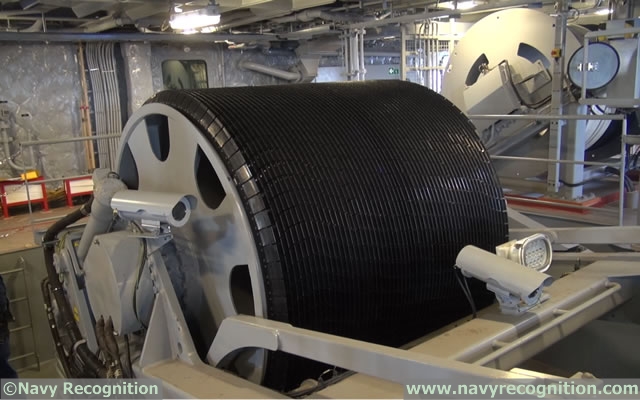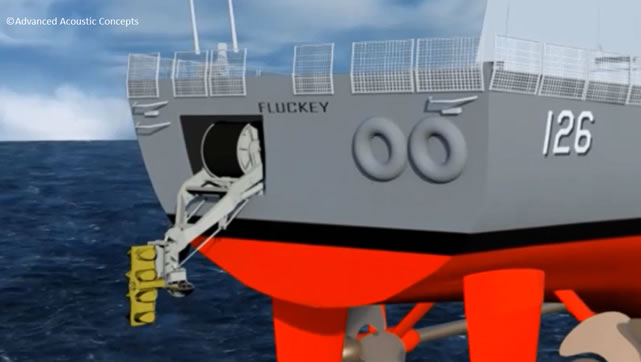 CAPTAS-4 Variable Depth Sonar (and parts of the handling system) aboard
a French Navy FREMM Frigate (Aquitaine class).
CAPTAS-4 Variable Depth Sonar (and parts of the handling system) aboard
a French Navy FREMM Frigate (Aquitaine class). |
|||
During
Sea Air Space 2015, Patrick Vincent, director of business development,
undersea warfare at Thales Underwater Systems told Navy Recognition
that AAC, in collaboration with Thales, had just received a US Navy contract
to study weight reduction on the CAPTAS-4 system for the Littoral Combat
Ship (LCS) Anti-Submarine Warfare (ASW) Mission Package. Nine month later,
at SNA 2016 last week, an AAC representative explained that "the
VDS for the LCS ASW mission package is now lighter than requirement set
by the U.S. Navy". |
|||
 Reeling system for the CAPTAS-4 Variable Depth Sonar tether aboard a French
Navy FREMM Frigate (Aquitaine class).
Reeling system for the CAPTAS-4 Variable Depth Sonar tether aboard a French
Navy FREMM Frigate (Aquitaine class). |
|||
The
weight reduction comes from weight optimization in the handling system
of the VDS, AAC explained. A higher grade steel was used for the LCS VDS
handling system (compared to the one used for the FREMM's VDS handling
system). In addition, Navy Recognition learned that the length
of the tether connecting the VDS to the ship is shorter on the LCS (again,
compared to a FREMM frigate). The reeling system is therefore probably
more compact and lighter. Three companies are competing to provide VDS for the US Navy LCS: L-3, Raytheon, and AAC. Navy Recognition understands that the US Navy should select up to two of the contractors imminently to deliver a production test article (a single unit). Following an evaluation by the US Navy, full production would follow. The US Navy has a need for 10 VDS systems for the LCS and up to 20 for the LCS Frigate. AAC's VDS transmitter was selected by the US Navy to meet ASW Escort Mission requirement for the Littoral Combat Ship (LCS). |
|||
 ACC computer rendering showing CAPTAS-4 Variable Depth Sonar on a DDG
51 Flight III Destroyer
ACC computer rendering showing CAPTAS-4 Variable Depth Sonar on a DDG
51 Flight III Destroyer |
|||
In
addition, a video on the AAC stand featured an Arleigh Burke-class (DDG
51) Flight III fitted with a VDS (CAPTAS-4). AAC representatives explained
that AAC has proposed that the U.S. Navy consider equipping the future
destroyers with a VDS as part of the “Distributed Lethality”
concept. The concept of "Distributed Lethality" was introduced
(and is being advocated) by Vice Admiral Thomas Rowden, the Commander
of the U.S. Navy's surface forces. It can be summarized by fitting more
weapons on more vessels in order to "deceive the enemy, target the
enemy, and destroy the enemy". Talking to Navy Recognition, Jim Gray, AAC VP of Business Development said “AAC is pleased to have been selected to perform a design study of the VDS for LCS. AAC believes our VDS offering will add significant capability to the fleet by enhancing LCS and potentially other ships.” Navy Recognition believes a DDG 51 fitted with a CAPTAS-4 VDS, in addition to the MH-60R "Romeo" (and its FLASH/ALFS dipping sonar) deploying from the destroyer, would make a very potent anti-submarine warfare platform. Royal Navy (UK) and Marine Nationale (France) frigate captains have repeatedly praised the CAPTAS-4 / FLASH sonar combo, saying on many occasions it is the best and most potent ASW solution available today. FLASH sonars and CAPTAS-4 body are made in Brest in France. The ceramic rings from the CAPTAS-4 are made in Australia. In case of a US Navy contract, the handling system would be made in the United States. |
|||
SNA 2016: AAC Eager to See the CAPTAS-4 VDS Aboard U.S. Navy LCS and DDG 51 Flight III
- Posted On










